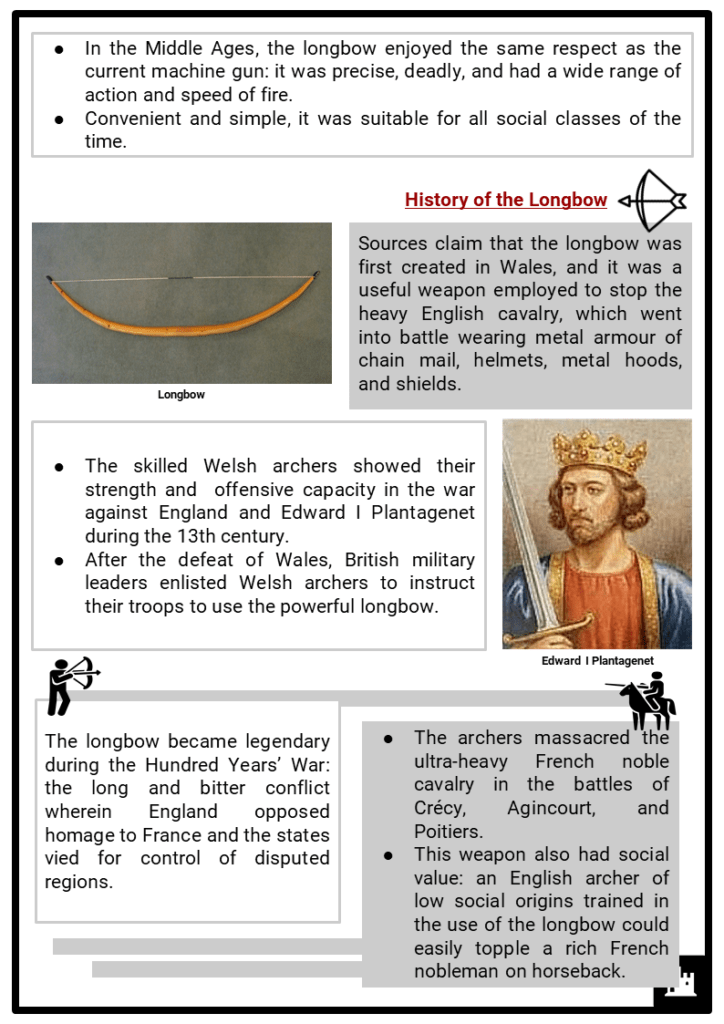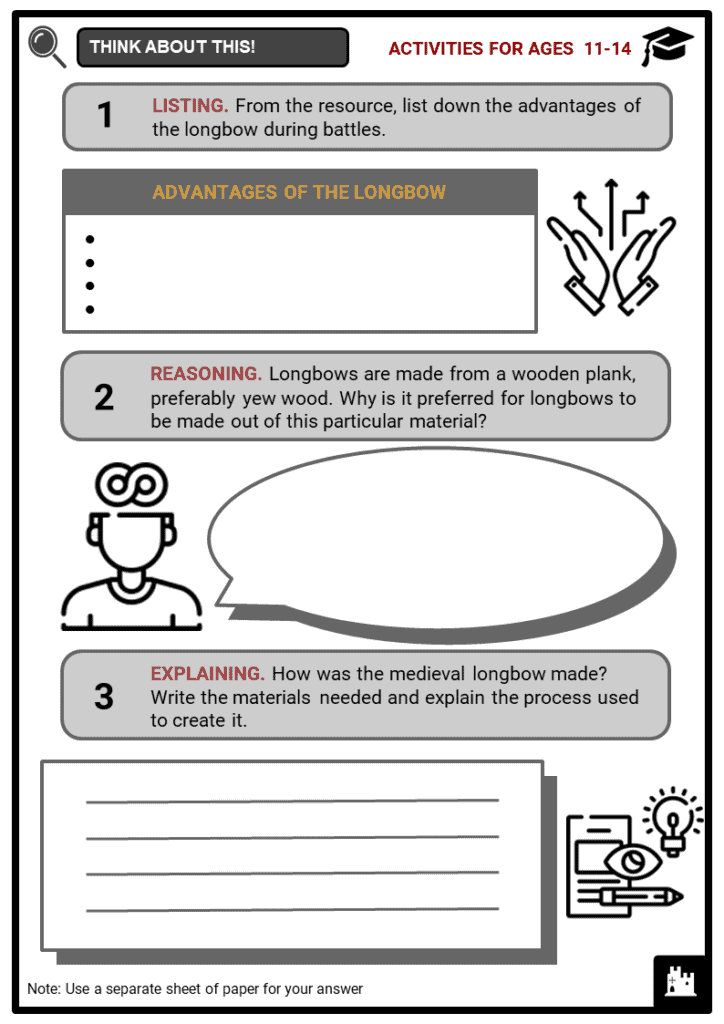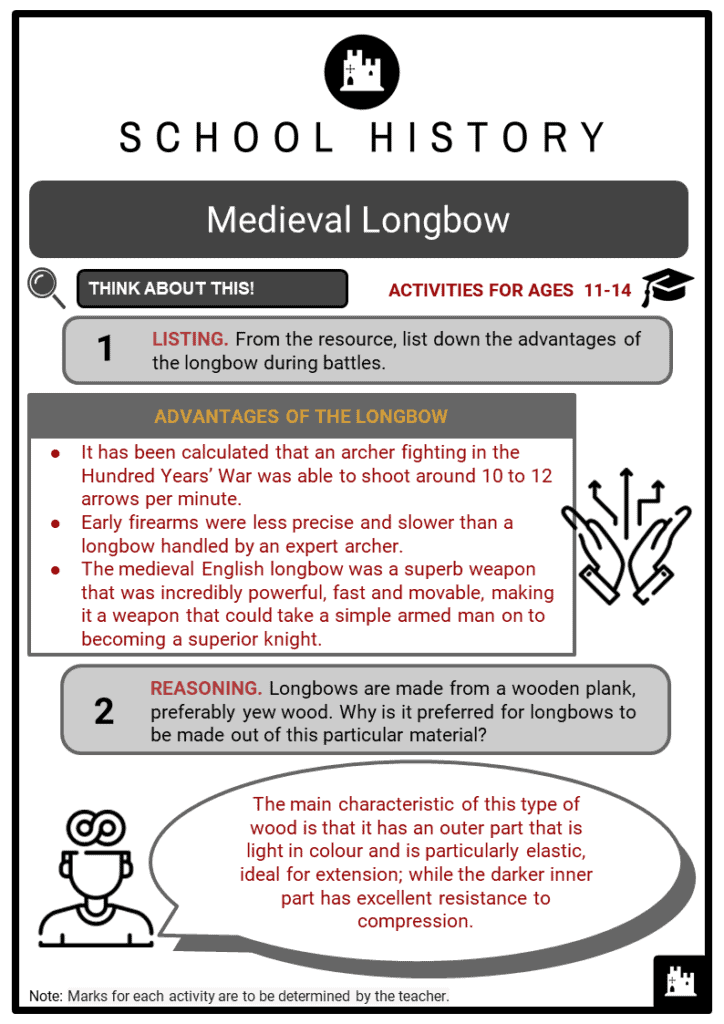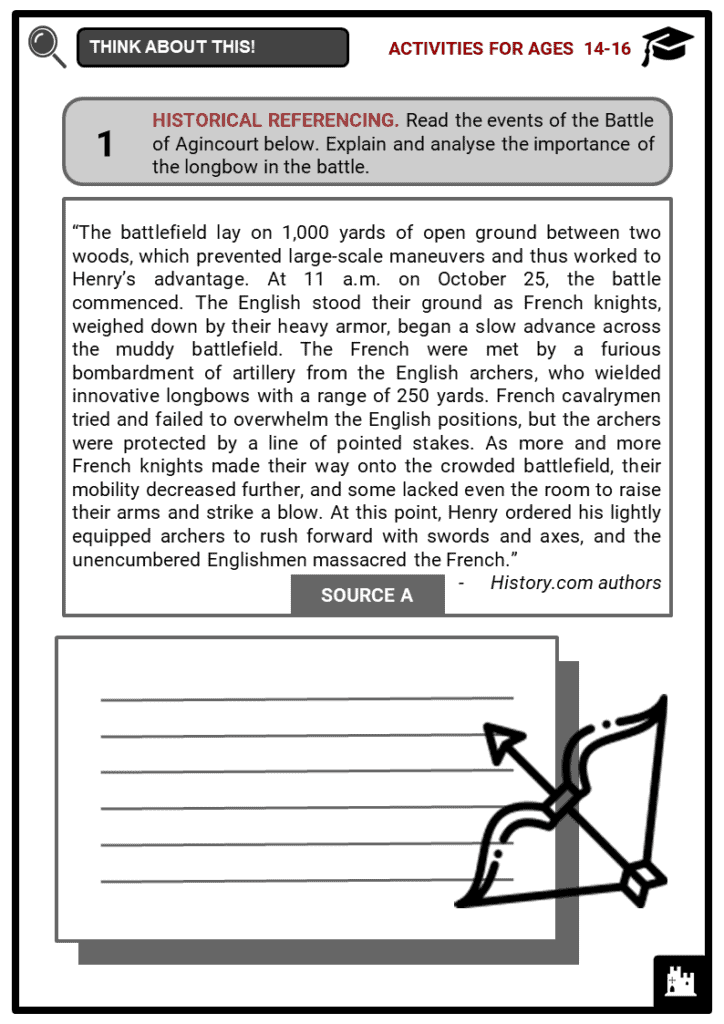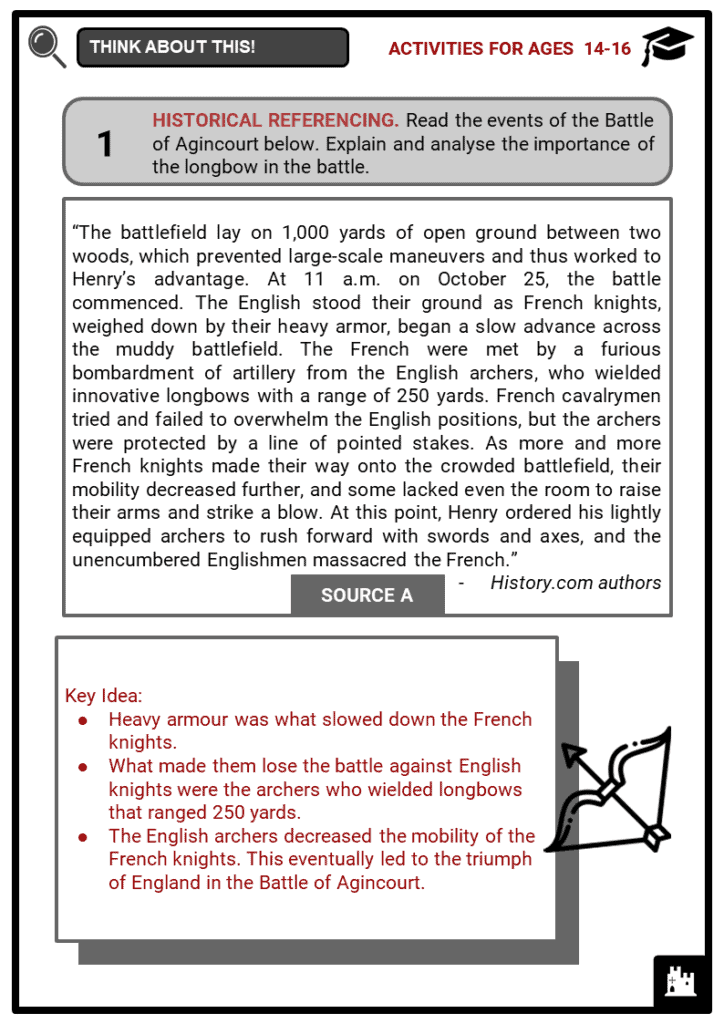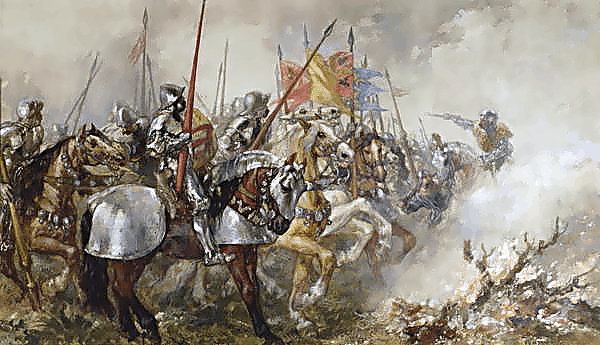Download Medieval Longbow Worksheets
Do you want to save dozens of hours in time? Get your evenings and weekends back? Be able to teach Medieval Longbow to your students?
Our worksheet bundle includes a fact file and printable worksheets and student activities. Perfect for both the classroom and homeschooling!
Table of Contents
Add a header to begin generating the table of contents
Summary
- Origin and history of the Medieval Longbow
- What is a longbow
- Longbow in battles: Battle of Agincourt
Key Facts And Information
Let’s know more about the Medieval Longbow!
- The main reason why England won the Battle of Agincourt was because of its archers and their use of longbows.
- In fact, the English longbow determined not only the outcome of Agincourt but also allowed England to win many other battles such as Crécy and Poitiers.
- From the 13th century until the 16th century, the longbow was the English army’s main weapon.
- It was thanks to this weapon that England conquered Wales and then Scotland.
- It also allowed Britain to win the Hundred Years’ War and to take France’s place as a military power in medieval Europe.
- In the Middle Ages, the longbow enjoyed the same respect as the current machine gun: it was precise, deadly, and had a wide range of action and speed of fire.
- Convenient and simple, it was suitable for all social classes of the time.
History of the Longbow
- Sources claim that the longbow was first created in Wales, and it was a useful weapon employed to stop the heavy English cavalry, which went into battle wearing metal armour of chain mail, helmets, metal hoods, and shields.
- The skilled Welsh archers showed their strength and offensive capacity in the war against England and Edward I Plantagenet during the 13th century.
- After the defeat of Wales, British military leaders enlisted Welsh archers to instruct their troops to use the powerful longbow.
- The longbow became legendary during the Hundred Years’ War: the long and bitter conflict wherein England opposed homage to France and the states vied for control of disputed regions.
- The archers massacred the ultra-heavy French noble cavalry in the battles of Crécy, Agincourt, and Poitiers.
- This weapon also had social value: an English archer of low social origins trained in the use of the longbow could easily topple a rich French nobleman on horseback.
- The longbow can be considered the medieval machine gun.
- It has been calculated that an archer fighting in the Hundred Years’ War was able to shoot around 10 to 12 arrows per minute.
- This weapon was in use for a certain period alongside the first firearms, which, on the whole, turned out to be easier to use and more powerful.
- Early firearms were less precise and slower than a longbow handled by an expert archer, however, longbows still had their place until firearms became more popular thanks to training.
- This development saw the longbow relegated to the role of hunting and tournaments.
- Such debate is due to the scarcity of specimens of this weapon.
- Today, there is still much confusion and controversy over the origins of the longbow.
- The oldest longbows that we possess are five specimens that date back to the Renaissance period and they are all very similar to each other.
- They are all about six feet long, made out of wood, and possess considerable rigidity.
- Overall, we can state with a degree of certainty that the longbow was introduced to England from Scandinavia probably during one of the many invasions that the Danes carried out around the middle of the year 1000.
- According to some historians, seven well-preserved longbows were discovered in remains of funeral boats found at Nydam Moor in Denmark in 1863.
- Thanks to scientific study, the longbows have been dated to between 200 and 400 BC and have many characteristics of the five English specimens.
- Recently, Dr. A. Lieshf of the University of Oslo discovered a longbow in a Viking’s tomb.
- The wood had completely deteriorated but a metal band used as reinforcement remained.
- The medieval English longbow was a superb weapon that was incredibly powerful, fast and movable, making it a weapon that could take a simple armed man on to becoming a superior knight.
What is a Longbow?
- A longbow is made from a single wooden plank, preferably (but not exclusively) yew wood.
- This type of wood has an outer part that is light in colour and is particularly elastic, ideal for extension; while the darker inner part has excellent resistance to compression.
- Therefore, this type of wood generates a naturally perfect effect for the mechanics of the longbow.
- The wood used to make a longbow was divided into long, intact and continuous segments without cracks and left to dry for one to two years.
- Entire forests were destroyed in order to obtain wood for making bows throughout Europe as ash, elm, and hazel were also widely used for creating this weapon.
- At the end of the drying period, the wood was worked by a specialised craftsman who gave it a particular shape: the typical D-shape was about 5 centimetres wide and tapered at the ends, which were reinforced with horn nocks in order to affix the string.
- In most cases, the string was made of woven hemp and flax, however, for the most prestigious customers, it could even be made of silk.
- What sometimes changed was the length of the arch, since the weapons had to be proportionate to those who used it.
- The longbow is not an invention which occurred in a specific historical period.
- In fact, thanks to some archeological findings, today we are aware that such a weapon existed long before the English started to employ it.
- It is worth remembering that the Similaun warrior (the famous Ötzi who died in 3,200 BC) was found with a 182 cm long wooden arch (which was very long for a man about 160 cm tall).
- Around thirty years ago, many longbows were found on the Mary Rose ship.
- This ship sank around 1545 and carried approximately 250 long arches measuring from a minimum of 187 cm to a maximum of 211 cm.
- The average arch measured 198cm.
- Contemporary scholars claim that the typical English longbow measured around 174 cm.
- However, arches with these dimensions also date back to the Roman period and the Vikings.
- Some longbows found in Somerset date back to 27 centuries before Christ.
- At this time, this is the only indication that the longbow may be an English invention.
- Some claim it was the Welsh who invented it.
- It is worth remembering, however, that the Welsh were the worst paid among the archers in the service of the English kings: they were paid less than the mercenary crossbowmen and even less than the English archers.
- Moreover, the chronicles of the Anglo-Norman invasion of Ireland (1169-70) claim that the Normans enlisted Welsh youth (about 5/6 of the expedition) and the Irish suffered heavily from the effects of their arrows.
- Replicas of bows like those on the Mary Rose have been demonstrated to withstand maximum traction of 84kg, with an average of about 70kg.
- With arrows that weighed half a pound, the longbows were able to shoot a distance of about 330 m.
- Arrows that weighed one pound could reach up to 250 m.
- During a sporting event, one of Edward III’s archers reached a distance close to 370 m.
- However, during their training, archers had to aim for their target, which often consisted of a cloth lying on the ground.
- This target was placed at least 200 m away, which was the typical maximum shooting distance in battle.
- By pure calculation of the probabilities, it was more about the number of arrows drawn that could inflict injury on an opponent’s uncovered points.
- The speed of the arrow was determined by the amount of thrust given to it.
- This factor determined the ideal length of the arrow, too.
- Determining the arrow’s length involved a calculation that is anything but simple.
- But, as you can guess, the length of the arrow depended on the length of the arc.
Longbows in the Battle of Agincourt
- The Battle of Agincourt shows a great English victory over the French during the Hundred Years' War (1337-1453).
- This battle together with other English victories in the Hundred Years' War (such as the Battle of Crécy in 1346 and the Battle of Poitiers in 1356), resulted in England's conquest of Normandy as well as the Treaty of Troyes in 1420, that recognised Henry V as the heir to the French crown.
- On the morning of October 25th, Henry arranged his army for battle with his men-at-arms stationed at the middle, adjoined by English longbow archers whose bows had an effective range of 250 yards.
- The area of the battle particularly favoured the Englishmen and disadvantaged the French.
- The English archers eventually abandoned their longbows and charged and massacred the French using their swords and axes.
- This led to the triumph of the English and the recognition of Henry V as the heir to the French crown.
- The battle of Agincourt showed the impact of longbows on English victory.
- The battle started with Henry's army wielding their longbows.
- The terrain and heavy armour made it difficult for the French to advance and thus slowed them down.
- When the first line of the French made their attack, they were unable to advance as the English archers were protected by sharpened stakes.
Image sources:
[2.] https://upload.wikimedia.org/wikipedia/commons/1/1b/Englishlongbow.jpg


